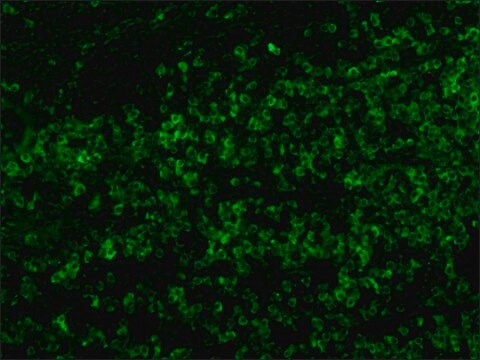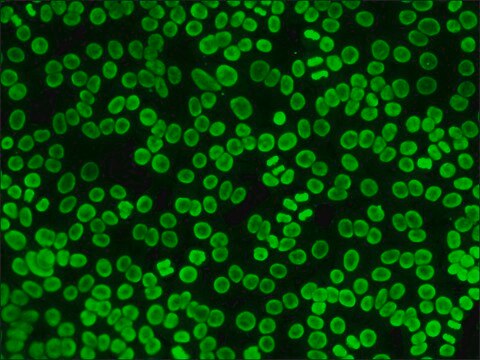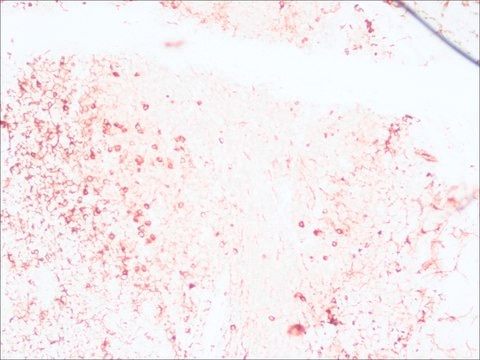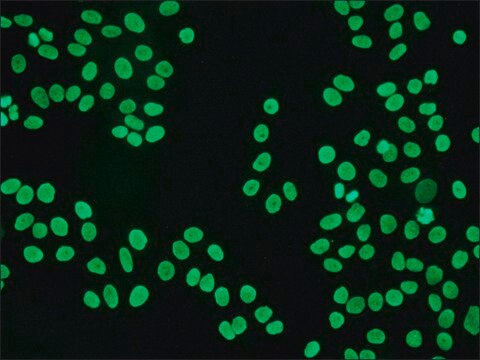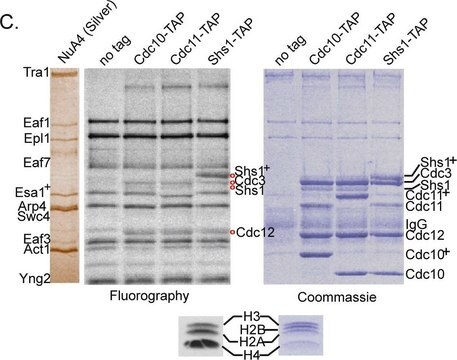AP113F
Goat Anti-Human IgG Antibody, Fc, FITC conjugate
2 mg/mL, Chemicon®
Sign Into View Organizational & Contract Pricing
All Photos(1)
About This Item
UNSPSC Code:
12352203
eCl@ss:
32160702
NACRES:
NA.46
Recommended Products
biological source
goat
Quality Level
conjugate
FITC conjugate
antibody form
affinity purified immunoglobulin
antibody product type
secondary antibodies
clone
polyclonal
species reactivity
human
manufacturer/tradename
Chemicon®
concentration
2 mg/mL
technique(s)
immunofluorescence: suitable
shipped in
wet ice
target post-translational modification
unmodified
Related Categories
Specificity
Shows a single band when run in an IEP system at a minimum concentration of 10 mg/mL, using human whole serum as the antigen. Reacts with Human IgG Fc fragment. No reactivity to other human immunoglobulins is observed.
Application
Goat anti-Human IgG Antibody, Fc, FITC conjugate is an antibody against Human IgG for use in IF.
Research Category
Secondary & Control Antibodies
Secondary & Control Antibodies
Research Sub Category
Fragment Specific Secondary Antibodies
Fragment Specific Secondary Antibodies
Suggested dilution for most applications: 1:50-1:200
Optimal working dilutions must be determined by the end user.
Optimal working dilutions must be determined by the end user.
Physical form
PRESENTATION: Liquid 0.02M Phosphate buffer, 0.25M NaCl, pH 7.6 with 15 mg/mL BSA, 0.1% sodium azide.
FLUOROPHORE/PROTEIN:
12.0 μg/mg
FLUOROPHORE/PROTEIN:
12.0 μg/mg
Storage and Stability
Maintain at 2-8°C in undiluted aliquots for up to 6 months. DO NOT FREEZE. Store in the dark.
Legal Information
CHEMICON is a registered trademark of Merck KGaA, Darmstadt, Germany
Disclaimer
Unless otherwise stated in our catalog or other company documentation accompanying the product(s), our products are intended for research use only and are not to be used for any other purpose, which includes but is not limited to, unauthorized commercial uses, in vitro diagnostic uses, ex vivo or in vivo therapeutic uses or any type of consumption or application to humans or animals.
Not finding the right product?
Try our Product Selector Tool.
Storage Class
12 - Non Combustible Liquids
wgk_germany
WGK 2
flash_point_f
Not applicable
flash_point_c
Not applicable
Certificates of Analysis (COA)
Search for Certificates of Analysis (COA) by entering the products Lot/Batch Number. Lot and Batch Numbers can be found on a product’s label following the words ‘Lot’ or ‘Batch’.
Already Own This Product?
Find documentation for the products that you have recently purchased in the Document Library.
Tumor-derived tissue factor activates coagulation and enhances thrombosis in a mouse xenograft model of human pancreatic cancer.
Wang, JG; Geddings, JE; Aleman, MM; Cardenas, JC; Chantrathammachart, P; Williams et al.
Blood null
Gang Wu et al.
Wellcome open research, 6, 134-134 (2022-03-01)
Background: Siglec-1 is a macrophage lectin-like receptor that mediates sialic acid-dependent cellular interactions. Its upregulation on macrophages in autoimmune disease was shown previously to promote inflammation through suppressing the expansion of regulatory T cells (Tregs). Here we investigate the molecular
Sophia Semerdjieva et al.
Molecular and cellular biology, 33(7), 1442-1455 (2013-02-06)
Regulation of the activity of N-methyl-d-aspartate receptors (NMDARs) at glutamatergic synapses is essential for certain forms of synaptic plasticity underlying learning and memory and is also associated with neurotoxicity and neurodegenerative diseases. In this report, we investigate the role of
Johannes Hartl et al.
The Journal of experimental medicine, 218(5) (2021-03-31)
Antibodies to double-stranded DNA (dsDNA) are prevalent in systemic lupus erythematosus (SLE), particularly in patients with lupus nephritis, yet the nature and regulation of antigenic cell-free DNA (cfDNA) are poorly understood. Null mutations in the secreted DNase DNASE1L3 cause human
Congwen Wei et al.
Nature metabolism, 2(12), 1391-1400 (2020-11-28)
Responsible for the ongoing coronavirus disease 19 (COVID-19) pandemic, severe acute respiratory syndrome coronavirus 2 (SARS-CoV-2) infects host cells through binding of the viral spike protein (SARS-2-S) to the cell-surface receptor angiotensin-converting enzyme 2 (ACE2). Here we show that the
Our team of scientists has experience in all areas of research including Life Science, Material Science, Chemical Synthesis, Chromatography, Analytical and many others.
Contact Technical Service
